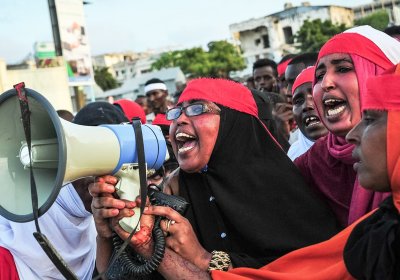Three things stand out about the October 14 truck bomb attack in the Somali capital Mogadishu.
First is the huge number of casualties. The detonation of a large truck packed with explosives created an apocalyptic scene of carnage. It levelled nearby buildings, killing at least 327 people and injuring more than 400 others.
Somalia
Under President Barack Obama, the US acknowledged killing between 2867 and 3138 people in strikes in countries like Somalia, Yemen and Pakistan.
In the waning days of his presidency, Obama took some steps to improve transparency about drone strikes, including providing the total estimated death toll. However, a new report by the Columbia Law School Human Rights Clinic and the Sana’a Center for Strategic Studies says that the US is still lagging in providing a full accounting of its drone program.
It is amazing the conversations one overhears sometimes.
I was attending a vigil for Omid Masoumali, the young asylum seeker who died a few days after he set himself on fire in Australia's notorious refugee detention camp in Nauru. The atmosphere at the vigil was sad and tense. Among those at vigil were two young women quietly holding flickering candles.
Another woman holding a Teachers for Refugees banner asked the young women: “What school are you from?”
“I am not at school,” replied one of the young women.
The United States used drones and manned aircraft on March 8 to drop bombs and missiles on Somalia, ending the lives of at least 150 people.
As it virtually always does, the Obama administration instantly claimed the people killed were “terrorists” and militants — members of the Somali group al-Shabaab — but provided no evidence.
The U.S. government will release a count of how many people it has killed in "counterterrorism" strikes since 2009, the Obama administration announced on March 7. Meanwhile, US air strikes killed 150 people in Somalia, in an attackt he US said was targetted at the al-Shabab terrorist group, an affiliate of al-Qaida.
Reversing earlier promises to end US military involvement in Afghanistan, President Barack Obama has announced that US troops will remain indefinitely. He said they will not be ground combat forces, but trainers and advisers to the forces of the US-imposed warlord-dominated regime.
US air strikes in support of the regime, by both piloted aircraft and drones, will continue. One such strike was the deliberate bombing of the Doctors Without Borders (MSF) hospital in Kunduz.
Terrorists from Somali Islamist group al-Shabaab massacred 142 students at Garissa University in northern Kenya on April 2. In response, the Kenyan airforce bombed what they said were al-Shabaab camps in Somalia on April 5 and 6.
Kenyan forces have been occupying Somalia since October 2011, under African Union (AU) auspices, along with troops from Uganda and Burundi.
On April 7, students protested in Garissa and the Kenyan capital, Nairobi, against the seven-hour delay in security forces reaching the university during the attack.
An “extraordinary summit” of the African Union in the Ethiopian capital, Addis Ababa, on October 11 and 12 took place without a threatened mass withdrawal of AU member nations from the International Criminal Court (ICC).
The mass withdrawal threat was in response to the ongoing prosecution by the ICC of Kenyan President Uhuru Kenyatta and Vice-President William Ruto. They were elected in March this year while already facing charges for political violence after Kenya’s previous elections in 2007.
The logic of terrorism is violent political theatre ― the aim is not just to inflict harm but to be widely noticed inflicting harm.
From this perspective, the Somali militia al Shabaab’s September 21 seizure of the upmarket Westgate Shopping Mall in Nairobi, Kenya, and massacre of at least 61 hostages, was a successful act of terrorism.
But while al Shabaab successfully dominated world headlines with their brutal attack, the media has almost entirely ignored the context: the Western-backed occupation of Somalia by Kenya, Uganda and Burundi.
On October 16, Kenyan forces entered southern Somalia. The invasion is aimed against the Islamist militia al Shabaab. It is in response to a recent rise in cross-border kidnappings of Westerners, with four abducted in the past month.
Kenya is not the only regional country with soldiers in Somalia, which has not had a functioning government since 1991. An African Union force of 9000 Ugandan and Burundian troops has been in the country since January 2009, when it replaced an Ethiopian force.
AU troops have launched their own offensive against al Shabaab.
More than 13 million people are facing extreme food insecurity in the Horn of Africa in Ethiopia, Somalia, Eritrea, Djibouti, Sudan, South Sudan, Uganda and Kenya.
Almost 30,000 children have already died in Somalia in 90 days.
Famines in the region have become common enough for the Western media response to be cliched. Out-of-context images and sound-bites depict hopeless Africans needing Western charity yet again, and references to conflict making the situation worse depict conflict as local failing that Western intervention may be able to remedy.
- Page 1
- Next page









